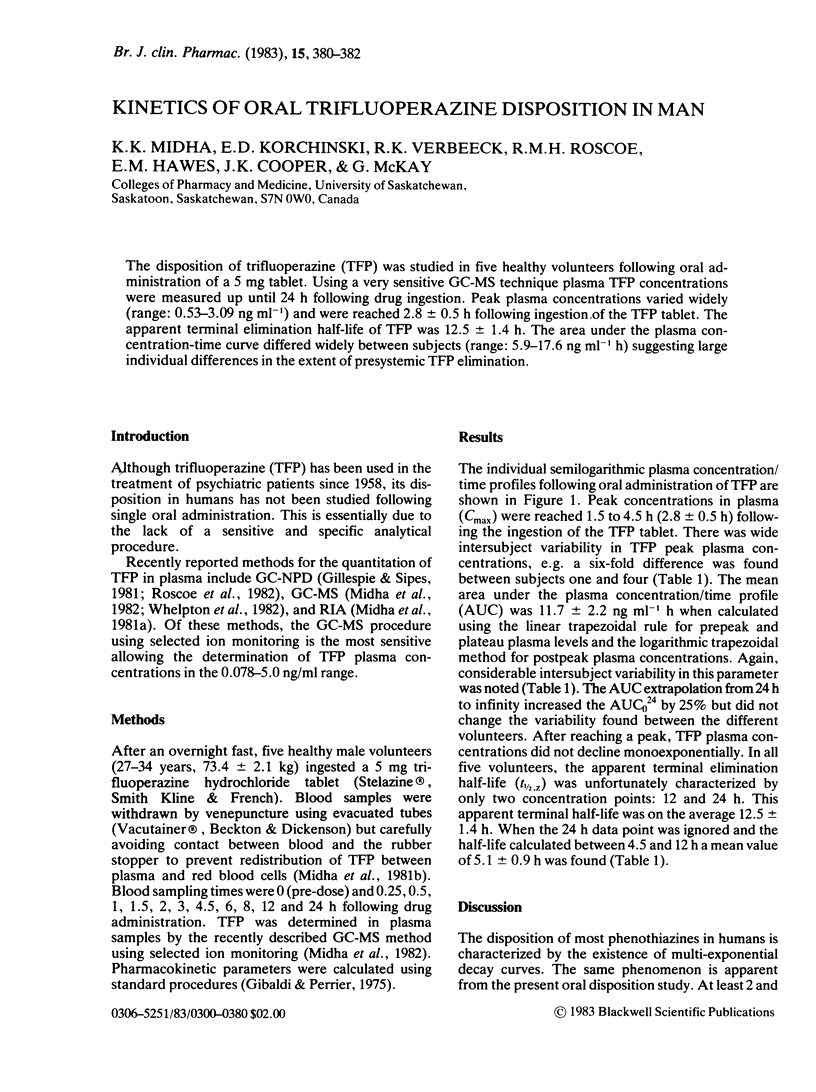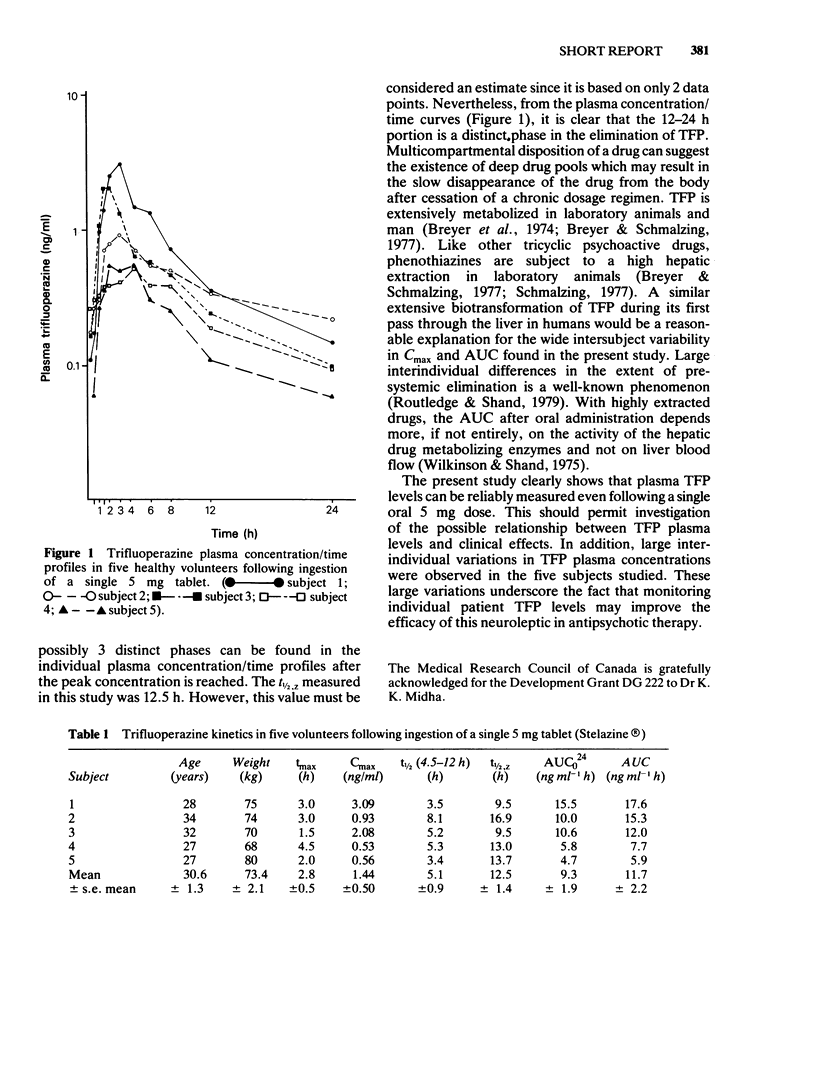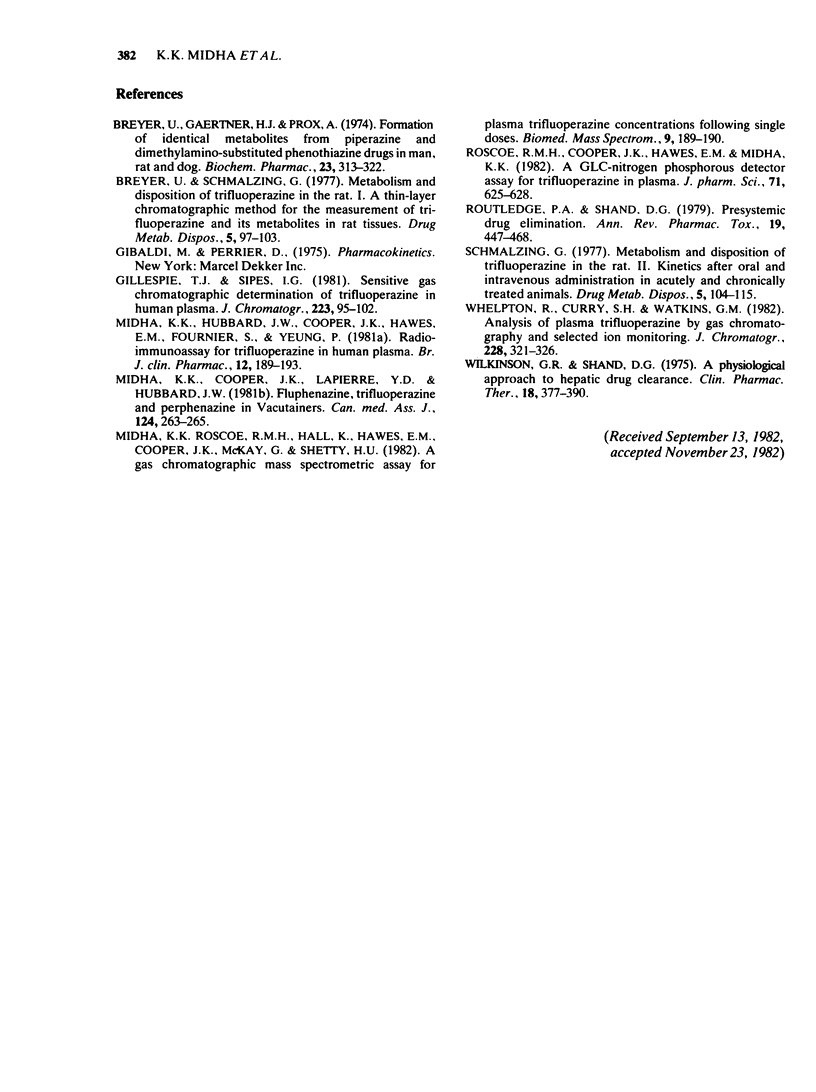Abstract
The disposition of trifluoperazine (TFP) was studied in five healthy volunteers following oral administration of a 5 mg tablet. Using a very sensitive GC-MS technique plasma TFP concentrations were measured up until 24 h following drug ingestion. Peak plasma concentrations varied widely (range 0.53-3.09 ng ml-1) and were reached 2.8 +/- 0.5 h following ingestion of the TFP tablet. The apparent terminal elimination half-life of TFP was 12.5 +/- 1.4 h. The area under the plasma concentration-time curve differed widely between subjects (range: 5.9-17.6 ng ml-1 h) suggesting large individual differences in the extent of presystemic TFP elimination.
Full text
PDF


Selected References
These references are in PubMed. This may not be the complete list of references from this article.
- Breyer U., Gaertner H. J., Prox A. Formation of identical metabolites from piperazine- and dimethylamino-substituted phenothiazine drugs in man, rat and dog. Biochem Pharmacol. 1974 Jan 15;23(2):313–322. doi: 10.1016/0006-2952(74)90422-5. [DOI] [PubMed] [Google Scholar]
- Breyer U., Schmalzing G. Metabolism and disposition of trifluoperazine in the rat. I. A thin-layer chromatographic method for the measurement of trifluoperazine and its metabolites in rat tissues. Drug Metab Dispos. 1977 Mar-Apr;5(2):97–103. [PubMed] [Google Scholar]
- Gillespie T. J., Sipes I. G. Sensitive gas chromatographic determination of trifluoperazine in human plasma. J Chromatogr. 1981 Apr 10;223(1):95–102. doi: 10.1016/s0378-4347(00)80071-7. [DOI] [PubMed] [Google Scholar]
- Midha K. K., Cooper J. K., Lapierre Y. D., Hubbard J. W. Fluphenazine, trifluoperazine and perphenazine in Vacutainers. Can Med Assoc J. 1981 Feb 1;124(3):263–265. [PMC free article] [PubMed] [Google Scholar]
- Midha K. K., Hubbard J. W., Cooper J. K., Hawes E. M., Fournier S., Yeung P. Radioimmunoassay for trifluoperazine in human plasma. Br J Clin Pharmacol. 1981 Aug;12(2):189–193. doi: 10.1111/j.1365-2125.1981.tb01199.x. [DOI] [PMC free article] [PubMed] [Google Scholar]
- Midha K. K., Roscoe R. M., Hall K., Hawes E. M., Cooper J. K., McKay G., Shetty H. U. A gas chromatographic mass spectrometric assay for plasma trifluoperazine concentrations following single doses. Biomed Mass Spectrom. 1982 May;9(5):186–190. doi: 10.1002/bms.1200090503. [DOI] [PubMed] [Google Scholar]
- Roscoe R. M., Cooper J. K., Hawes E. M., Midha K. K. A GLC-nitrogen phosphorous detector assay for trifluoperazine in plasma. J Pharm Sci. 1982 Jun;71(6):625–627. doi: 10.1002/jps.2600710607. [DOI] [PubMed] [Google Scholar]
- Routledge P. A., Shand D. G. Presystemic drug elimination. Annu Rev Pharmacol Toxicol. 1979;19:447–468. doi: 10.1146/annurev.pa.19.040179.002311. [DOI] [PubMed] [Google Scholar]
- Schmalzing G. Metabolism and disposition of trifluoperazine in the rat. II. Kinetics after oral and intravenous administration in acutely and chronically treated animals. Drug Metab Dispos. 1977 Mar-Apr;5(2):104–115. [PubMed] [Google Scholar]
- Whelpton R., Curry S. H., Watkins G. M. Analysis of plasma trifluoperazine by gas chromatography and selected ion monitoring. J Chromatogr. 1982 Mar 12;228:321–326. doi: 10.1016/s0378-4347(00)80448-x. [DOI] [PubMed] [Google Scholar]
- Wilkinson G. R., Shand D. G. Commentary: a physiological approach to hepatic drug clearance. Clin Pharmacol Ther. 1975 Oct;18(4):377–390. doi: 10.1002/cpt1975184377. [DOI] [PubMed] [Google Scholar]


